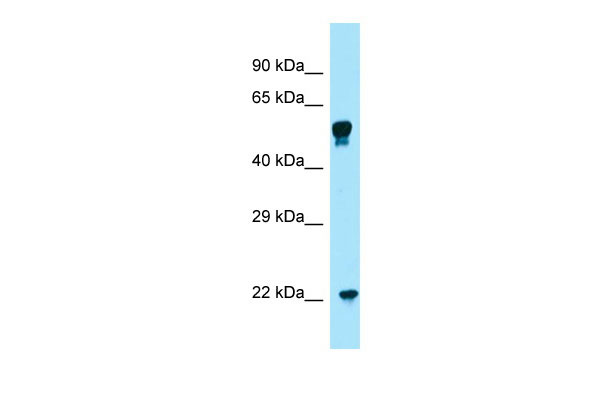COQ7 antibody - C-terminal region
Rabbit Polyclonal Antibody
- 产品详情
- 实验流程
Application
| WB |
|---|---|
| Primary Accession | Q99807 |
| Other Accession | NM_001190983, NP_001177912 |
| Reactivity | Human, Mouse, Rat, Rabbit, Dog, Guinea Pig, Horse, Bovine, Yeast |
| Predicted | Human, Mouse, Rat, Rabbit, Pig, Dog, Guinea Pig, Horse, Bovine, Yeast |
| Host | Rabbit |
| Clonality | Polyclonal |
| Calculated MW | 24277 Da |
| Gene ID | 10229 |
|---|---|
| Alias Symbol | CAT5, CLK-1, CLK1 |
| Other Names | Ubiquinone biosynthesis protein COQ7 homolog, Coenzyme Q biosynthesis protein 7 homolog, Timing protein clk-1 homolog, COQ7 |
| Format | Liquid. Purified antibody supplied in 1x PBS buffer with 0.09% (w/v) sodium azide and 2% sucrose. |
| Reconstitution & Storage | Add 50 ul of distilled water. Final anti-COQ7 antibody concentration is 1 mg/ml in PBS buffer with 2% sucrose. For longer periods of storage, store at 20°C. Avoid repeat freeze-thaw cycles. |
| Precautions | COQ7 antibody - C-terminal region is for research use only and not for use in diagnostic or therapeutic procedures. |
| Name | COQ7 {ECO:0000255|HAMAP-Rule:MF_03194, ECO:0000312|HGNC:HGNC:2244} |
|---|---|
| Function | Catalyzes the hydroxylation of the 5-methoxy-2-methyl-3-(all- trans-polyprenyl)benzoquinone at the C6 position and participates in the biosynthesis of ubiquinone (Probable). Catalyzes the reaction through a substrate-mediated reduction pathway, whereby NADH shuttles electrons to 5-methoxy-2-methyl-3-(all-trans-decaprenyl)benzoquinone, which then transfers the electrons to the two Fe(3+) centers (PubMed:23445365). The binding of 5-methoxy-2-methyl-3-(all-trans- polyprenyl)benzoquinone (DMQn) mediates reduction of the diiron center by nicotinamide adenine dinucleotide (NADH) and initiates oxygen activation for subsequent DMQ hydroxylation (PubMed:23445365). The physiological substrates are 5-methoxy-2-methyl-3-(all-trans- nonaprenyl)benzoquinone (DMQ(9)) and 5-methoxy-2-methyl-3-(all-trans- decaprenyl)benzoquinone (DMQ(10)), however in vitro the enzyme does not have any specificity concerning the length of the polyprenyl tail, and accepts tails of various lengths with similar efficiency (PubMed:23445365, PubMed:28409910). Also has a structural role in the COQ enzyme complex, stabilizing other COQ polypeptides. Involved in lifespan determination in a ubiquinone-independent manner (By similarity). Plays a role in modulating mitochondrial stress responses, acting in the nucleus, perhaps via regulating gene expression, independent of its characterized mitochondrial function in ubiquinone biosynthesis (PubMed:25961505). |
| Cellular Location | Mitochondrion inner membrane {ECO:0000255|HAMAP- Rule:MF_03194}; Peripheral membrane protein {ECO:0000255|HAMAP- Rule:MF_03194}; Matrix side {ECO:0000255|HAMAP-Rule:MF_03194} Mitochondrion. Nucleus. Chromosome |
| Tissue Location | Expressed dominantly in heart and skeletal muscle. |
Research Areas
For Research Use Only. Not For Use In Diagnostic Procedures.
Application Protocols
Provided below are standard protocols that you may find useful for product applications.
REFERENCES
Asaumi S.,et al.Genomics 58:293-301(1999).
Wiemann S.,et al.Genome Res. 11:422-435(2001).
Ota T.,et al.Nat. Genet. 36:40-45(2004).
Martin J.,et al.Nature 432:988-994(2004).
Mural R.J.,et al.Submitted (JUL-2005) to the EMBL/GenBank/DDBJ databases.
终于等到您。ABCEPTA(百远生物)抗体产品。
点击下方“我要评价 ”按钮提交您的反馈信息,您的反馈和评价是我们最宝贵的财富之一,
我们将在1-3个工作日内处理您的反馈信息。
如有疑问,联系:0512-88856768 tech-china@abcepta.com.























 癌症的基本特征包括细胞增殖、血管生成、迁移、凋亡逃避机制和细胞永生等。找到癌症发生过程中这些通路的关键标记物和对应的抗体用于检测至关重要。
癌症的基本特征包括细胞增殖、血管生成、迁移、凋亡逃避机制和细胞永生等。找到癌症发生过程中这些通路的关键标记物和对应的抗体用于检测至关重要。 为您推荐一个泛素化位点预测神器——泛素化分析工具,可以为您的蛋白的泛素化位点作出预测和评分。
为您推荐一个泛素化位点预测神器——泛素化分析工具,可以为您的蛋白的泛素化位点作出预测和评分。 细胞自噬受体图形绘图工具为你的蛋白的细胞受体结合位点作出预测和评分,识别结合到自噬通路中的蛋白是非常重要的,便于让我们理解自噬在正常生理、病理过程中的作用,如发育、细胞分化、神经退化性疾病、压力条件下、感染和癌症。
细胞自噬受体图形绘图工具为你的蛋白的细胞受体结合位点作出预测和评分,识别结合到自噬通路中的蛋白是非常重要的,便于让我们理解自噬在正常生理、病理过程中的作用,如发育、细胞分化、神经退化性疾病、压力条件下、感染和癌症。






